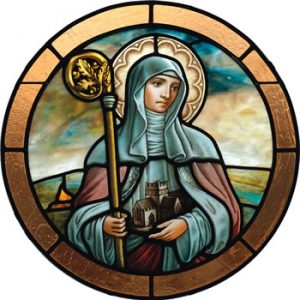The Secondary Patrons of Ireland – St Brigid
St. Brigid of Kildare
The very youngest years of the life of St. Brigid of Kildare overlap the final years of St. Patrick (d. 461). St. Brigid directly influenced several other future saints of Ireland, and her many religious communities helped to secure the country's conversion from paganism to the Catholic faith.
According to one of the more credible biographies of Brigid, she was born around 450, near the end of St. Patrick's life. Brigid was born out of wedlock, the daughter of a pagan chieftain named Dubthach and a Christian slave woman named Broicsech. The chieftain sold the child's pregnant mother to a new master, but contracted for Brigid to be returned to him eventually. We can imagine her, the illegitimate child of a slave growing up on the Kildare plains, helping her mother by herding the cattle, milking them and making butter. The child was probably baptized as an infant and raised as a Catholic by her mother. Thus, she was well-formed in the faith before leaving Broicsech's slave-quarters, at around age 10, to live with Dubthach and his wife.
It is notoriously hard to establish the historical details of Brigid’s life, and the various accounts make many conflicting claims. But, contrary to revisionist historians, St. Brigid is not merely a Christianized form of the pagan Irish goddess "Brigida." She was a real Irish woman who was named after this goddess. After all, Brigid’s father was a pagan chieftain, so he named her after the false Celtic goddess Brigida, a goddess of fire, and roughly akin to the Roman goddess Minerva. Other Irish women at the time were named Morgan (after the Irish battle goddess), or Macha (after the Irish horse goddess).
Brigid's faith found expression in acts of charity. From the abundance of her father's food and possessions, she gave generously to the poor. Dubthach became enraged, threatening to sell Brigid – who was not recognized as a full family member, but worked as a household servant – to the King of Leinster. But the Christian king understood Brigid's acts of charity and convinced Dubthach to grant his daughter her freedom. The stories of Brigid were circulating so near her own time that it is very unlikely that they are completely out of character. Brigid was known for her patience, prayerfulness and compassion. Brigid gave away to the poor and unfortunate her shawl, her purse, her father's gold, her grandfather’s dinner, wine, meat, her shoes and also those of her relatives. Having nothing else at hand, she even gave her father's jeweled sword to a leper.
Released from servitude, Brigid was expected to marry. But she had other plans, which involved serving God in consecrated life. As one author wrote, “And Brigid being Brigid, she got her own way.” Understanding he could not change her mind, Dubthach granted Brigid permission to pursue her plan (perhaps to avoid bankruptcy because of his daughter’s generosity). Thus did a pagan nobleman, through this gift to his illegitimate daughter, play an unintentional but immense part in God's plan for Ireland.
Brigid, with an initial group of seven companions, is credited with organizing communal consecrated religious life for women in Ireland. Bishop Mel of Ardagh accepted Brigid's profession as a nun. Mel went on to serve as a mentor to the group during their time at Ardagh. Around the time of his death in 488, Brigid's community got an offer to resettle. Their destination is known today as Kildare (“Church of the Oak”), after the main monastery she founded there.
Brigid's life as a nun was rooted in prayer, but it also involved substantial manual labor: clothmaking, dairy farming, and raising sheep. In Ireland, as in many other regions of the Christian world, this communal combination of work and prayer attracted vast numbers of people during the sixth century. From this main monastery, Brigid's movement branched out to encompass a large portion of Ireland. It is not clear just how large, but it is evident that Brigid traveled widely throughout the island, founding new houses and building up a uniquely Irish form of monasticism.
Under Brigid's leadership, Kildare played a major role in the successful Christianization of Ireland. As a child Brigid's faith found expression in acts of charity. Like Brigid’s childhood home, the monastery of Kildare soon became known for its extensive almsgiving. The abbess' influence was felt in the subsequent era of the Irish Church, a time when the country became known for its many monasteries and their intellectual achievements.
St. Brigid of Kildare died around 525. Brigid was an Irish nun, abbess, and founder of several convents and was the most famous female leader of the early Celtic church. Irish missionaries made Brigid a popular saint for converted pagans all over Europe too – especially in pre-Reformation times Brigid of Kildare had many British and continental followers. Considered as one of Ireland's patron saints, she ranks only behind Saint Patrick himself in importance. Her feast day is February 1st, traditionally considered the first day of spring in Ireland. Brigid is patron of travelers, pilgrims, farm animals and midwives.

 Entries(RSS)
Entries(RSS)